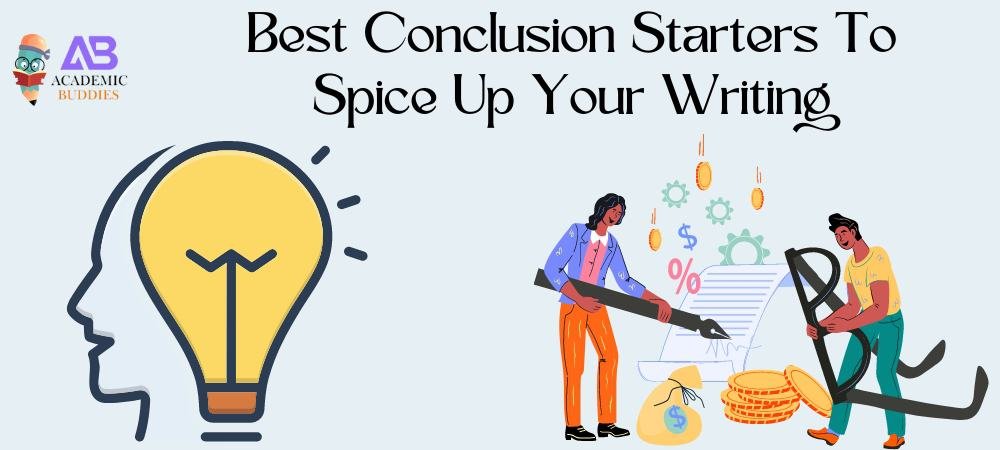Introduction
Mastering the art of concluding any written piece requires meticulous attention to detail and a profound comprehension of the reader’s journey. Whether it’s the final remark in an argumentative essay, the concluding scene in a narrative, or the last chapter of a dissertation, your sign-off holds substantial influence. Employing conclusion starters transforms summarizing strategies, closing sentences, and concluding paragraphs into seamless transitions, enriching your work’s canvas. These essential phrases, from the impactful conclusion of a speech to the meticulous closure of a report, act as the linchpin, sealing your message with clarity and conviction. Ultimately, the goal is to resonate your core message, providing readers with a profound understanding and a sense of closure.
Effective Strategies for Crafting Impactful Conclusions
Writing a compelling conclusion is an art that gives your essay or paper a sense of completeness and leaves a lasting impression on the reader. To achieve this, employing strategic conclusion starters is key. These starters serve as a signal to the reader that the writer is summarizing the main points and wrapping up the discussion.
Summarizing with Precision
Begin your conclusion with clear and concise phrases that reflect the essence of your arguments. Phrases like “In summary,” “To conclude,” or “Ultimately” pave the way for a final overview. This approach allows you to reiterate the core findings of your work without introducing new information, ensuring that the reader is reminded of the essay’s strengths and the evidence that supports your arguments.
Encouraging Reflection
A concluding paragraph should go beyond mere summarization, prompting the reader to contemplate the significance of the subject matter. Phrases like “Upon careful consideration,” “Taking these factors into account,” or “Given this evidence” invite readers to reflect on the broader implications of your arguments. This approach elevates the substance of your conclusion, transforming it into more than a simple recapitulation—it evolves into a conclusive and thoughtful pause on the subject.
Inviting Action
For papers that aim to persuade or motivate, using action-oriented starters can be very effective. Phrases like “Moving forward,” “With this in mind,” or “As a call to action” suggest that the reader should take specific steps after reading. This method is particularly useful in driving home the practical applications of your findings or the urgency of the issues discussed.
In crafting your conclusion, remember that it is the final opportunity to reinforce your thesis and main points. A well-executed conclusion starter sets the tone for this closure, ensuring that your writing remains impactful and memorable long after the reader has finished your work.
The Significance of Strong Closing Sentences
The closing sentence of any written piece is not just a formality but a crucial component that anchors the reader’s experience. A well-crafted closing sentence can elevate the entire piece, leaving a resonant impression that extends beyond the final words.
Solidifying Your Argument
A closing sentence serves as the final word on your argument, encapsulating the essence of your discussion. It’s the part that often lingers in the reader’s mind, reinforcing the main points and ensuring that your message is clear and memorable. By restating the thesis or the most compelling point in a fresh way, it solidifies your argument, giving it weight and closure.
Creating a Lasting Impact
The power of a good closing sentence lies in its ability to resonate with the reader. It’s an opportunity to underscore the relevance of your topic and to leave the reader with something to ponder. Whether it’s a call to action, a thought-provoking question, or a poignant statement, the goal is to create a lasting impact that encourages further thought or action.
Enhancing Readability and Flow
In terms of style, the concluding sentence plays a crucial role in giving the entire piece a cohesive and harmonious feel. It functions as the concluding chord in the composition of your writing, resonating with clarity and purpose. A skillfully crafted conclusion should seamlessly blend in, providing a satisfying and natural end, whereas a poorly constructed or abrupt ending may disrupt the reader’s engagement and weaken the impact of the preceding text.
In crafting your closing sentence, consider it as the definitive seal on your argument, the echo of your main points, and the final brushstroke on the canvas of your writing. It’s an indispensable tool in the writer’s kit, ensuring that your message doesn’t just end, but concludes with intention and impact.
Initiating a Compelling Conclusion Paragraph
The beginning of a conclusion paragraph is a critical juncture in your writing that requires a strategic approach. Here’s a structured method to ensure your conclusion starts effectively, without directly mentioning linguistic strategies or keyword optimization.
| Step | Action | Purpose |
| 1. Transition Smoothly | Start with transitional phrases like “In conclusion,” “To wrap up,” or “Finally,” | These phrases signal the end of your discourse and prepare the reader for the summary. |
| 2. Restate the Thesis | Paraphrase your thesis statement succinctly. | This reminds the reader of your central argument and reinforces the essay’s purpose. |
| 3. Summarize Main Points | Briefly recap the main points of your essay. | A concise summary synthesizes the information, making it easier for the reader to remember. |
| 4. Address the ‘So What?’ | Explain the significance of your argument. | Highlighting the importance of your findings connects the dots for the reader, showing why your essay matters. |
| 5. Propose Actions or Questions | Suggest further research, actions, or pose rhetorical questions. | This encourages the reader to think beyond the essay and consider the broader implications. |
| 6. End with a Strong Sentence | Conclude with a powerful statement or a call to action. | A memorable final sentence leaves a lasting impression and can provoke thought or action. |
By adhering to the structure provided in this table, you can formulate a concluding paragraph that not only summarizes the content of your essay but also underscores its importance, prompting the reader to reflect on the subject well beyond the completion of their reading.
Crafting a Conclusion: A Structured Guide
Starting a conclusion effectively is a skill that can make your writing stand out. A conclusion serves as the final chance to emphasize your main points and leave a lasting impression on your reader. Here’s a fresh outline to guide you in crafting a compelling conclusion:
- Signal the Conclusion: Begin with a clear indication that you are concluding your essay. Use phrases like “In summary,” “To conclude,” or “Ultimately,” to signal the end of your discussion.
- Restate the Thesis: Reinforce your thesis statement by restating it in a new light. This shouldn’t be a mere repetition but a reiteration that reflects the insights gained from your essay.
- Highlight Key Points: Briefly touch upon the main points of your argument. This synthesis should bring together your essay’s most persuasive arguments in a way that relates them back to the thesis.
- Synthesize, Don’t Summarize: Instead of simply summarizing the points you’ve made, synthesize them. Show how the points come together to support your thesis. This is where you weave the threads of your argument into a cohesive picture.
- Implications and Recommendations: Discuss the broader implications of your findings or argument. If appropriate, recommend actions, further research, or pose a question to encourage critical thinking and engagement.
- Concluding Thoughts: End with a strong, impactful statement. This could be a poignant quote, a call to action, or a statement that underscores the relevance of your discussion.
Remember, the conclusion is your final word on the subject. It should encapsulate the essence of your arguments and leave your reader with a clear understanding of your standpoint and why it matters. Make every word count, and ensure that your conclusion resonates with the reader, reinforcing the strength and significance of your work.
Crafting the Perfect Conclusion: A Structured Approach
Starting a conclusion effectively is crucial for leaving a lasting impression on your reader. Here’s a structured outline to guide you through crafting a powerful conclusion without delving into the specifics of language processing or keyword strategies.
Begin with a Signal
- Transition: Use a clear transition phrase such as “In summary,” “Ultimately,” or “Conclusively,” to signal the start of your conclusion.
- Purpose: This sets the tone for a final synthesis of your ideas.
Echo the Core Message
- Thesis Restatement: Paraphrase your thesis statement to remind the reader of your essay’s central theme.
- Relevance: It reinforces the main message and links back to the introduction.
Synthesize the Key Points
- Summary of Arguments: Briefly outline the main points you’ve made throughout your essay.
- Clarity: This recapitulation helps to consolidate your argument and aids in the reader’s comprehension.
Highlight the Significance
- Importance: Explain why your arguments matter, giving your essay a sense of importance and relevance.
- Engagement: This encourages the reader to consider the implications of your findings.
Propose Further Thought
- Future Implications: Suggest areas for further research or questions that arise from your essay.
- Curiosity: Provoking thought ensures that your essay remains with the reader beyond the final word.
Conclude with Strength
- Final Statement: End with a powerful statement that encapsulates your essay’s conclusion.
- Impact: A strong closing remark ensures that your essay concludes on a memorable note.
Following this structure, you can formulate a concluding paragraph that not only concisely recaps the key points of your essay but also underscores its importance, providing the reader with a comprehensive grasp of your argument and its wider consequences.
High School Conclusion Starter Ideas: Boost Your Writing!
Crafting a strong conclusion is essential for any high school essay, as it leaves the reader with a final impression of your work. Here are some effective conclusion starters that can help high school students wrap up their essays with clarity and impact:
- “In essence,” – This phrase distills the essay down to its most fundamental points, emphasizing the core message.
- “Ultimately,” – It suggests a sense of finality and resolution, summarizing the essay’s findings.
- “Reflecting on this,” – Encourages the reader to consider the essay’s arguments and their significance.
- “Considering all aspects,” – This starter prompts a holistic view of the essay’s content, weighing all the points discussed.
- “To summarize,” – Offers a clear cue that you are about to condense the essay’s main points into a concise overview.
- “In conclusion,” – A classic and straightforward way to begin wrapping up your essay.
- “Drawing to a close,” – Signals the reader that the essay is coming to its final points.
- “After careful consideration,” – Implies that the conclusion is the result of thorough analysis of the essay’s content.
- “With this in mind,” – Prepares the reader for a conclusion that is based on the evidence and arguments presented.
- “To wrap things up,” – A casual yet effective way to signal the end of the discussion.
These starters are designed to help high school students guide their readers to the end of their essays smoothly and effectively, ensuring that the conclusion is a strong and integral part of the overall argument.
Effective Examples for Concluding Sentences
Creating a compelling conclusion for a college essay means leaving a sophisticated and lasting impression. Here are some dynamic conclusion paragraph starters that can help college students conclude their essays with intellectual vigor:
- “To culminate,” – This phrase indicates a high point of your argument, suggesting a comprehensive wrap-up.
- “Synthesizing the foregoing,” – Shows that you are bringing together all the elements of your argument.
- “Upon examination,” – Implies a final analysis or summary of the essay’s content.
- “In the final analysis,” – Indicates a deep and thorough recapitulation of the essay’s arguments.
- “As we have seen,” – Points back to the evidence and arguments presented throughout the essay.
- “To encapsulate,” – Suggests a concise and powerful summary of your main points.
- “In retrospect,” – Offers a reflective approach to the essay’s conclusion, considering the arguments in hindsight.
- “Foremost,” – Highlights the most significant points of the essay, bringing them to the forefront in the conclusion.
- “Navigating through this discourse,” – Implies a journey through the complex arguments that have been laid out.
- “In light of these points,” – Shines a final spotlight on the key arguments of the essay.
These starters are tailored to help college students craft conclusions that are not only summarizing the essay but also enhancing the depth and breadth of their scholarly discussion.
Concluding Thoughts on Assignment Help
In the journey of academic growth, the role of assignment help cannot be overstated. It serves as a crucial tool for students to enhance their understanding and improve their grades.
- Enhanced Understanding: With the support of academic buddies and expert guidance, students gain deeper insights into their subjects.
- Grade Improvement: Tailored assistance in assignments can significantly contribute to better academic performance.
- Time Management: Leveraging help allows students to manage their time more effectively, balancing academic and personal commitments.
In essence, the collaboration with academic buddies through assignment help is not just about completing tasks; it’s about enriching the educational experience. It empowers students to tackle complex challenges with confidence and secure their academic success.



